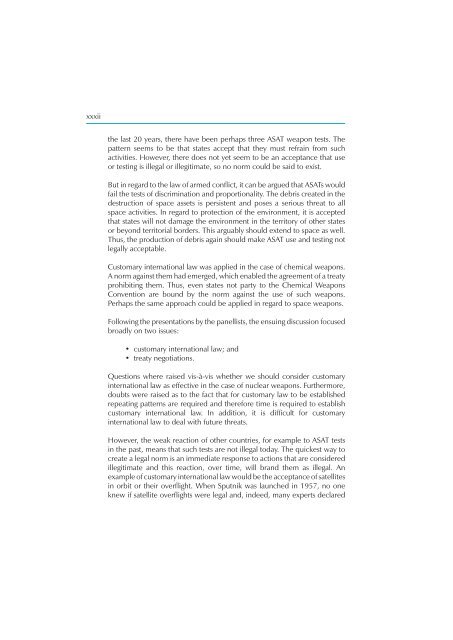Security in Space The Next Generation - UNIDIR
Security in Space The Next Generation - UNIDIR
Security in Space The Next Generation - UNIDIR
You also want an ePaper? Increase the reach of your titles
YUMPU automatically turns print PDFs into web optimized ePapers that Google loves.
xxxii<br />
the last 20 years, there have been perhaps three ASAT weapon tests. <strong>The</strong><br />
pattern seems to be that states accept that they must refra<strong>in</strong> from such<br />
activities. However, there does not yet seem to be an acceptance that use<br />
or test<strong>in</strong>g is illegal or illegitimate, so no norm could be said to exist.<br />
But <strong>in</strong> regard to the law of armed confl ict, it can be argued that ASATs would<br />
fail the tests of discrim<strong>in</strong>ation and proportionality. <strong>The</strong> debris created <strong>in</strong> the<br />
destruction of space assets is persistent and poses a serious threat to all<br />
space activities. In regard to protection of the environment, it is accepted<br />
that states will not damage the environment <strong>in</strong> the territory of other states<br />
or beyond territorial borders. This arguably should extend to space as well.<br />
Thus, the production of debris aga<strong>in</strong> should make ASAT use and test<strong>in</strong>g not<br />
legally acceptable.<br />
Customary <strong>in</strong>ternational law was applied <strong>in</strong> the case of chemical weapons.<br />
A norm aga<strong>in</strong>st them had emerged, which enabled the agreement of a treaty<br />
prohibit<strong>in</strong>g them. Thus, even states not party to the Chemical Weapons<br />
Convention are bound by the norm aga<strong>in</strong>st the use of such weapons.<br />
Perhaps the same approach could be applied <strong>in</strong> regard to space weapons.<br />
Follow<strong>in</strong>g the presentations by the panellists, the ensu<strong>in</strong>g discussion focused<br />
broadly on two issues:<br />
customary <strong>in</strong>ternational law; and<br />
treaty negotiations.<br />
Questions where raised vis-à-vis whether we should consider customary<br />
<strong>in</strong>ternational law as effective <strong>in</strong> the case of nuclear weapons. Furthermore,<br />
doubts were raised as to the fact that for customary law to be established<br />
repeat<strong>in</strong>g patterns are required and therefore time is required to establish<br />
customary <strong>in</strong>ternational law. In addition, it is diffi cult for customary<br />
<strong>in</strong>ternational law to deal with future threats.<br />
However, the weak reaction of other countries, for example to ASAT tests<br />
<strong>in</strong> the past, means that such tests are not illegal today. <strong>The</strong> quickest way to<br />
create a legal norm is an immediate response to actions that are considered<br />
illegitimate and this reaction, over time, will brand them as illegal. An<br />
example of customary <strong>in</strong>ternational law would be the acceptance of satellites<br />
<strong>in</strong> orbit or their overfl ight. When Sputnik was launched <strong>in</strong> 1957, no one<br />
knew if satellite overfl ights were legal and, <strong>in</strong>deed, many experts declared








